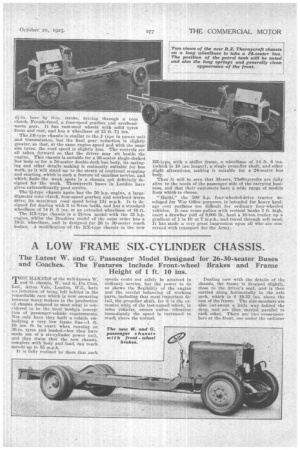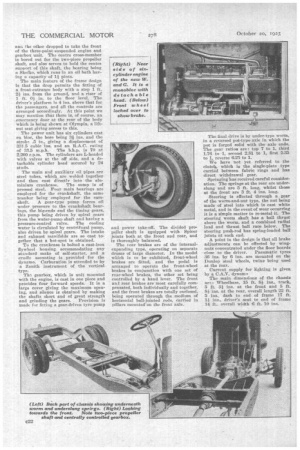A LOW FRAME SIX-CYLINDER CHASSIS.
Page 13

Page 14

If you've noticed an error in this article please click here to report it so we can fix it.
The Latest W. and G. Passenger Model Designed for 26-30-seater Buses and Coaches. The Features Include Front-wheel Brakes and Frame Height of 1 ft. 10 ins.
TMA.KEIRS of the well-knownsW. 1 and G. chassis, Wand G..Du -Cros, Ltd., Acton Vale, London, W.3., have nu intention of being left behind in the remarkable race which is now occurring between many makers in the production of chassis designed to meet what is conI.itiered to be the most modern conception of passenger-vehicle requirements. Not only have they built a vehicle embodying a very low frame line-1 ft. 10 ins. fo be exact when running on 36-in, tyres and loaded—but they have made use of a six-cylinder power unit, and they claim that the new chassis, complete with body and load, eau reach speeds up to 55 m.p.h.
it is fully realized by them that such speeds could not safely be attained in ordinary service, but the power to do so shows the flexibility of the engine and the careful balancing of working parts, including that most important detail, the propeller shaft, for it is the excessive whip of the last-named which, in some vehicles, causes undue vibration immediately the speed is increased to much above the normal.
Dealing now with the details of the chassis, the frame is dropped slightly, close to the driver's seat, and is then carried alonghorizontally to the axle arch, which is 8 19-32 ins, above the rest of the frame. The side members are deo cut-swept a little way behind the drop, and are then carried parallel to each other. There are two cross-members at the front, one under the radiator
am, the other dropped to take the front of the three-point-suspended engine and gearbox unit. The centre cross-member is bored out for the two-piece propeller shaft, and also serves to hold the centre support of this shaft, the bearing being a SkeEko, which runs in an oil bath having a capacity of 11 pints.
The main feature of the frame design is that the drop permits the fitting of a front-entrance body with a step 1 ft. 21 ins, from the ground, and a riser of 1 ft. 0/ in, to the floor level. The driver's platform is 4 ins, above that for the passengers, and all the controls are arranged accordingly. At this point we may mention that there is, of course, an emergency door at the rear of the body which is being shown at Olympia, a liftout seat giving access to this.
The power unit has six cylinders east en bloc, the bore being 3i ins, and the stroke .5 in., giving a displacement of 321.5 cubic ins, and an R.A.C. rating of 23.5 m.p.h. The b.h.p. is 70 at 2,200 r.p.m. The cylinders are L-headed with valves at the off side, and a detachable cylinder head secured by 24 studs.
The main and auxiliary oil pipes are steel tubes, which are welded together and then east directly into the aluminium crankcase. The sump is of pressed steel. Four main bearings are employed for the crankshaft, the same number being employed for the cam
shaft. A gear-type pump forces oil under pressure to the crankshaft bearings, the big-ends and the timing gears, this pump being driven by spiral gears from the water-pump shaft and having a pressure-control valve. The cooling water is circulated by centrifugal pump, also driven by spiral gears. The intake and exhaust manifolds are so cast together that a hot-spot is obtained.
To the crankcase is bolted a cast-iron flywheel housing accommodating any standard make of self-starter, and a cradle mounting is provided for the dynamo. Carburation is attended to by a Zenith instrument of the vertical type.
Th3 gearbox, which is unit mounted with the engine, is cast in one piece and provides four forward speeds. It is a large cover giving the maximum opening, and silence is obtained by making the shafts short and of great strength and grinding the gears. Provision is made for fitting a gear-driven tyre pump and power take-off. The divided propeller shaft is equipped with Spicer joints both at the front and rear, and is thoroughly balanced.
The rear brakes are of the internalexpanding type, operating on separate drums of large diameter. In the model which is to be exhibited, front-wheel brakes are fitted, and the pedal is arranged to operate the front-wheel brakes in conjunction with one set of rear-wheel brakes, the other set being controlled by a hand lever. The front and rear brakes are most carefully compensated, both individually and together, and the front brakes are totally enclosed, being operated through the medium of horizontal ball-jointed rods, carried in pillars mounted-on the front axle.
The final drive is by under-type worm, in a reversed pot-typo axle in which the pot is forged solid with the axle ends. The gear ratios are: top 7 to 1, third 1.76 to 1, second 2.81 to 1, first 5.35 to 1, reverse 6.25 to 1.
We have not yet referred to the clutch, which is the single-plate type carried between fabric rings and has direct withdrawal gear.
Springing has received careful consideration. The springs at the rear are underslung and are 5 ft. long, whilst those at the front are 3 ft. 4 ins. long.
Steering is effected through a gear of the worm-and-nut type, the nut being made of steel into which is cast white metal, and in the event of wear occurring it is a simple matter to re-metal it. The steering worm shaft has a ball thrust above the worm, and a combined radial load and thrust ball race below. The steering push-rod has spring-loaded ball joints at each end.
A point in the design is that all brake adjustments can be effected by wingnuts concentrated under the floor boards close to the driver. Pneumatic tyres 36 ins. by 6 ins. are mounted on the Dunlop steel wheels, twins being used at the rear.
Current supply for lighting is given by a C.A.V. dynmna
The main dimensions of the chassis : Wheelbase, 15 ft. 81 ins., track, 5 ft. n ins, at the front and 5 ft. 8/ ins, at the rear, overall length 22 ft. 5 ins., dash to end of frame 17 ft. 1/ ins., driver's seat to end of frame 14 ft., overall width -6 ft. 10 ins.




















































